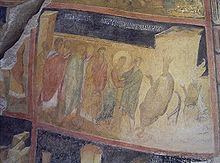Ivanovo rock churches
| Ivanovo rock churches | |
|---|---|
|
UNESCO world heritage |
|

|
|
| National territory: |
|
| Type: | Culture |
| Criteria : | (ii) (iii) |
| Surface: | 171.9 ha |
| Reference No .: | 45 |
| UNESCO region : | Europe and North America |
| History of enrollment | |
| Enrollment: | 1979 ( session 3 ) |
The rock churches of Ivanovo ( Bulgarian Ивановски скални църкви / Iwanowski Skalni zarkwi) are a group of Orthodox churches , chapels and monastery rooms that together form the former monastery of Ivanovo in northeastern Bulgaria .
location
The rock churches are located east of the village of Ivanovo in the Ruse Oblast , 22 kilometers southwest of the Danube city of Russe in northeastern Bulgaria. They can be reached from the village of Ivanovo on a four-kilometer access road. A few kilometers to the south are the ruins of the Cherven fortress . In the Middle Ages it was a strategically important and large city that housed a bishopric of the Bulgarian Orthodox Church . The medieval capital of the Second Bulgarian Empire , Veliko Tarnowo is located around 90 km south of Ivanovo.
history
As early as the end of the 12th century, individual hermits lived in the natural caves of the mountains and dug individual chambers in the soft limestone. The hermit Ioakim founded the Archangel Michael monastery from the isolated chambers, in which the individual rooms were partly connected by corridors (today many of these corridors have collapsed again).
The former tsar monastery, donors ( Ktitor ) were among others the Bulgarian tsars Iwan Assen II and Iwan Alexander , was carved into the flank of a steep rock of the mountains on the banks of the Rusenski Lom river between the 13th and 17th centuries . Thanks to their help, the monastery was the destination of the most outstanding contemporary artists in Bulgaria, the Tarnowo Art School .
In six churches and chapels of the complex there are still frescoes from the 13th and 14th centuries. The artists who worked there at the time are no longer known by name today.
The rock church of the Virgin Mary
The central monastery church, in which the most important frescoes are located, is dedicated to the Virgin Mary and is also simply called Zarkwata (Bulgarian “The Church”). It was carved into the rock at a height of 38 m above the road and consists of a naos , a narthex and an adjoining chapel.
The church is a good 16 m long, 4 m wide and only 2.15 m high. Her frescoes are divided into rectangular segments that depict the last seven days of Christ's life and the life of John the Baptist. In the narthex there are portraits of Tsar Ivan Alexander , Tsarina Theodora and some saints. The frescoes in the chapel show motifs from the life of early Syrian Christian hermits.
On October 22, 1979, the rock churches of Ivanovo were declared a World Heritage Site by UNESCO . In particular the frescoes of the rock church of the Virgin Mary were threatened by light, humidity and temperature fluctuations and above all by increasing tourism; therefore, they were closed to the public in the 1980s. Around the turn of the millennium, they were extensively conserved with financial help from UNESCO and made accessible to the public again in 2002.
More pictures
Web links
- Entry on the UNESCO World Heritage Center website ( English and French ).
- Ivanovo Monastery "St. Michael the Archangel". bulgarianmonastery.com
Coordinates: 43 ° 43 ′ 0 ″ N , 25 ° 58 ′ 0 ″ E







